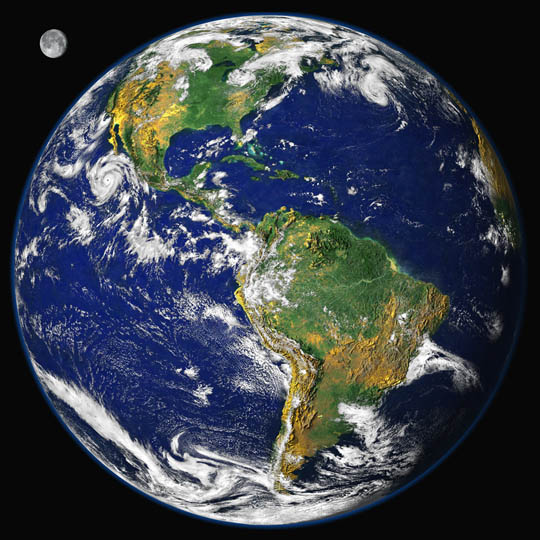







| BOOKS | F. A. Q. | ARTICLES | TALKS | ABOUT KEN | DONATE | BEYOND OUR KEN |
|---|
By Ken Croswell
Published in Earth (July 1993, page 13)

Credit: GOES satellite.
Image created by Reto Stockli with the help of Alan Nelson, under the leadership of Fritz Hasler.
The Appalachian Mountains presently run from Newfoundland down the eastern United States and into Georgia and Alabama. New work suggests that they may be the remnant of an immense mountain range that once extended into Argentina and possibly Antarctica.
Today's Appalachians consist of two parallel mountain belts with different ages. The younger belt formed about 250 million years ago, when the eastern United States collided with northwest Africa. The older belt dates back 460 million years, to the Ordovician period. Until now, most geologists had thought that this belt also resulted from an earlier collision between North America and northwest Africa.
 "But there is a tantalizing clue in Argentina that suggests that North America was adjacent to what is now the west coast of southern South America during the Ordovician," says Ian Dalziel of the University of Texas at Austin. The clue lies in an eroded Argentine mountain range whose age matches that of the old belt of the Appalachians. The old Argentine mountains contain limestone rocks that geologists have long known to harbor fossils of trilobites, extinct sea creatures that lived during the Ordovician period.
"But there is a tantalizing clue in Argentina that suggests that North America was adjacent to what is now the west coast of southern South America during the Ordovician," says Ian Dalziel of the University of Texas at Austin. The clue lies in an eroded Argentine mountain range whose age matches that of the old belt of the Appalachians. The old Argentine mountains contain limestone rocks that geologists have long known to harbor fossils of trilobites, extinct sea creatures that lived during the Ordovician period.
"These particular trilobites don't occur anywhere else in the world except North America and the far northwest of my native Scotland, which was once part of North America," says Dalziel. Writing in a recent issue of Geology, Dalziel and Argentine geologists Luis Dalla Salda, Carlos Cingolani, and Ricardo Varela interpret the trilobites as a sign that the east coast of North America collided with the west coast of southern South America 460 million years ago. This collision created a long mountain range--what is now the old part of the Appalachians and the equally old belt that runs through Argentina.
After the collision, North America tore away from South America, splitting the mighty mountain range in two and transferring the trilobites to Argentina. "North America then made a kind of clockwise motion," says Dalziel. It moved up the west coast and then the north coast of South America before hitting northwest Africa, the collision that created the younger belt of the Appalachians.
"One of my students refers to this hypothetical movement as North America's making something of an end run around South America," says Dalziel. "My Argentine colleagues get a little more poetic and say, `Ah, North America--she was a tango dancer. She was doing a tango around us."
To test their theory, Dalziel and his colleagues plan to sample rocks in Argentina and also Antarctica, whose Shackleton Mountains may also have been part of the same vast range.
Ken Croswell is the author of Magnificent Universe and Ten Worlds.
"Magnificent Universe by Ken Croswell is elegant and eloquent."--Washington Post. See all reviews of Magnificent Universe here.
"On the basis of its striking design and photographs, this handsome, large-format volume is well worthy of praise. And astronomer Croswell's concise yet conversational, information-packed text wins it sky-high accolades in the narrative sphere as well."--Publishers Weekly, starred review. See all reviews of Ten Worlds here.
| BOOKS | F. A. Q. | ARTICLES | TALKS | ABOUT KEN | DONATE | BEYOND OUR KEN |
|---|